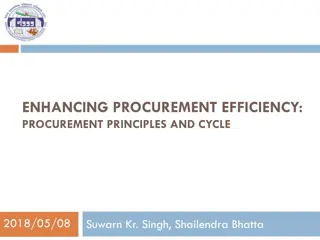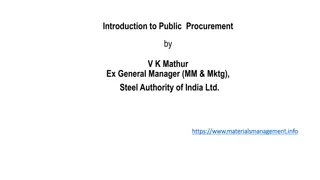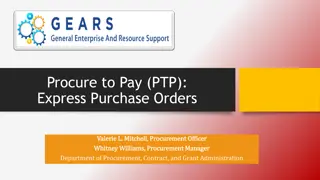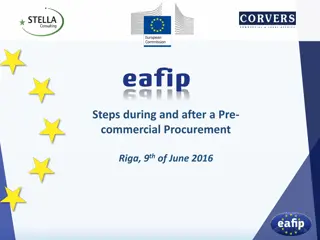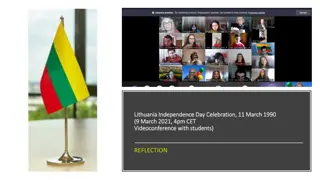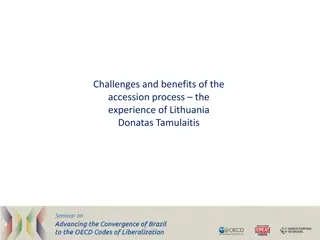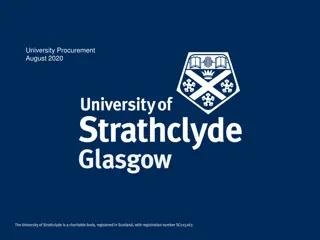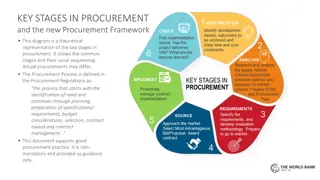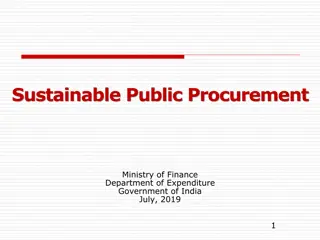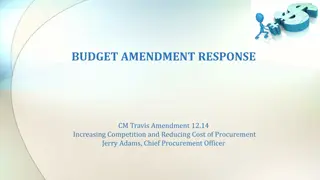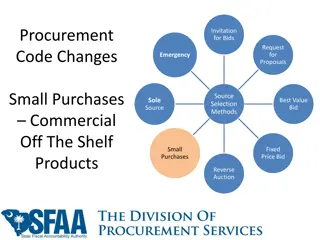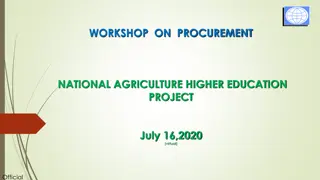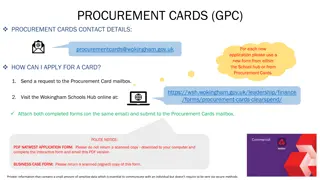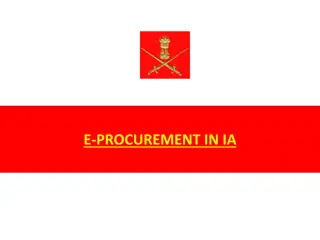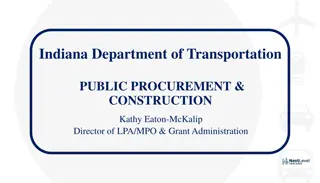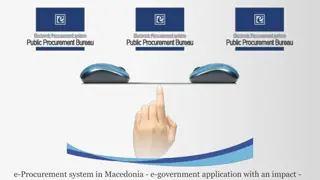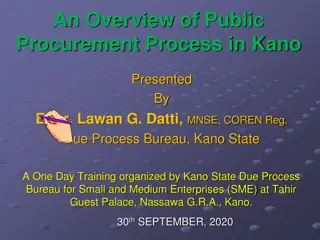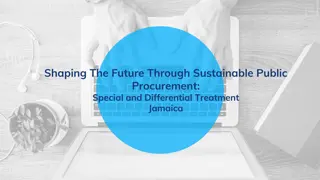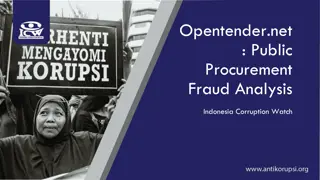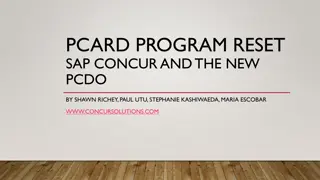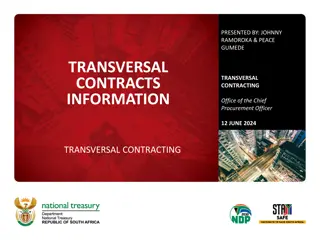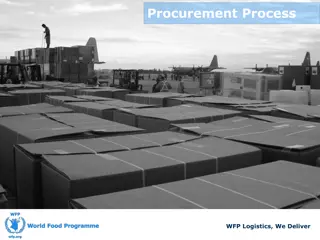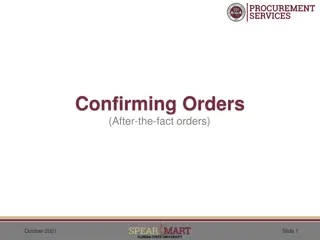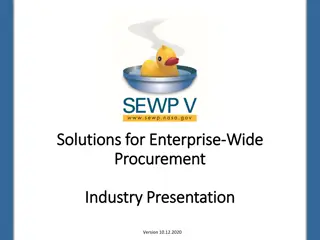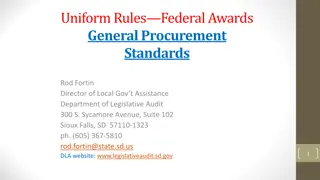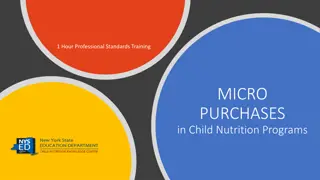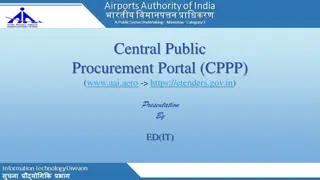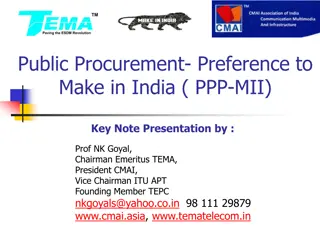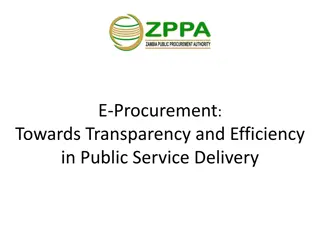Overview of Public Procurement System in Lithuania
The public procurement system in Lithuania is governed by various laws and regulations, covering different sectors such as concessions, defense/security, utilities, and classical sector. The system includes procedures for different monetary value procurements, including international, simplified, and low-value public procurements. All electronic public procurement procedures take place on the Central Public Procurement Information System (CVP IS) in Lithuania. Mandatory use of CVP IS ensures transparency and efficiency in public procurement processes.
Download Presentation

Please find below an Image/Link to download the presentation.
The content on the website is provided AS IS for your information and personal use only. It may not be sold, licensed, or shared on other websites without obtaining consent from the author. Download presentation by click this link. If you encounter any issues during the download, it is possible that the publisher has removed the file from their server.
E N D
Presentation Transcript
Public procurements in Lithuania ilvinas Briedis Paulius Murauskas Senior Associate Associate Vilnius, Lithuania 10th November 2021
I part: General overview of public procurement system in LT II part: registration and participation procedure III part: practical tips and legal aspects
I part: national legal environment Law on Concessions (following Directive 2014/23/EU) Concessions Law on Public Procurement in the Field of Defence and Security (following Directive 2009/81/EC) Defence/Security Sector Law on Public Procurement (following Directive 2014/24/EU) Classical Sector English version is available (with updates until 26 June 2018) Law on Procurement by the Entities Operating in the Water, Energy, Transport and Postal Services sectors (following Directive 2014/25/EU) Utilities Sector
I part: procurements by their monetary value 3 (three) types: international, simplified and low-value public procurements (i) more flexible procedures (ii) most of them published quite similarly as the international procurements International procurements value is equal or exceeds the European thresholds Simplified procurements value is less than international procurements EUR 5,350,000 (w/o VAT) (works contracts in any sector) Part of simplified procurements are low-value procurements which value is less than EUR 145,000 (w/o VAT) (works contracts in any sector) EUR 58,000 (w/o VAT) (supplies and services contracts in any sector) EUR 139,000 or EUR 214,000 (w/o VAT) (supplies and services contracts in the Classical Sector) EUR 428,000 (w/o VAT) (supplies and services contracts in the Utilities or Defence/Security Sectors)
I part: Central Public Procurement Information System In Lithuania all electronic public procurement procedures take place on a single portal - the Central Public Procurement Information System (Lithuanian abbreviation CVP IS or English abbreviation CPP IS). This system is run and administrated by the Public Procurement Office. Link https://cvpp.eviesiejipirkimai.lt/notice (some tabs are available in English language) The use of CVP IS is mandatory for every public procurement procedure with the exception of procedures that, under the national law and European directives, may be performed without prior publication International procurements are also published at TED (Tenders Electronic Daily). Link https://ted.europa.eu/TED/browse/browseByBO.do
I part: Central Public Procurement Information System https://cvpp.eviesiejipirkimai.lt/notice
I part: international, simplified, low-value procurement flagging
I part: prior announcements of upcoming procurements Each CA should prepare its annual public procurement plan and announce it until 15 March of ongoing calendar year. CA may amend the plan and to republish the relevant parts of it. Link https://cvpp.eviesiejipirkimai.lt/PlannedProcurement/List
I part: prior consultations with market participants CA is entitled to consult with market participants on the topics related to the upcoming procurement object via Central Public Procurement Information System (https://cvpp.eviesiejipirkimai.lt/notice) in several ways: (i) announce of preliminary Technical Specification and wait for remarks (ii) announce a questionnaire of relevant topics or conduct the discussion with market participants in any other transparent way Examples:
I part: alternative options of tracking procurements CVP codes establishes a single classification system for public procurement aimed at standardizing the references used by CA to describe the subject of procurement contracts. Link to CVP codes: https://simap.ted.europa.eu/cpv https://pirkimai.eviesiejipirkimai.lt/ (RSS feed by CVP codes). How to subscribe RSS feed in Google Chrome, press the link Private business offers IT solutions for automated and constant search of relevant procurements (e.g. https://www.etenders.lt/home). Search by CVP codes and / or relevant keywords.
I part: language of procurement documents Procurement documents have to be in national (Lithuanian) language and can be additionally published in other languages. The potential bidder may request a copy of documents in English or other language; however, it is up to CA discretion. Usually, the procurement documents are drafted in national language. Usually, the biggest or most important procurements are published both the Lithuanian and English languages. Foreign entities (i) translate the procurement documents themselves and / or (ii) have a local partner (contact) in Lithuania for a support (!) The bid (or at least its technical part) may be submitted in English language only (it is up to CA discretion).
I part: procurement procedure structure Commonly a procurement is published in a way of open tender or negotiation procedure (although there are other methods as well) Open tender Announcement procurement documents Evaluation of bids following the foreseen award criteria (price, quality). Announcement of results Bid submission following the foreseen deadline. The bid includes all technical and financial data Negotiations procedure Final Bid (including technical and pricing data), evaluation and tender results (including technical and pricing data) Initial Bid (including technical and pricing data) Negotiations (price, technical aspects, contract conditions) Application (no pricing or technical data) Announcement of procurement documents
I part: most important content of procurement documents Exclusion criteria and minimum qualification requirements Requirements for the procured object (Technical Specification) Main contract conditions / draft of procurement contract Award criteria (price, quality) Procurement budget, bid pricing conditions Procedural part of procurement
I part: clarifications, disputes Tenderer may request to clarify or amend procurement documents. The procedural term allowing to request for the clarifications / amendments is established in each procurement documents (usually, the procedural term to send requests is 6-9 calendar days before expiration of bid submision deadline). Tenderer may dispute procurement documents. Firstly, a mandatory pre- trial claim should be filed to the buyer (CA itself). Secondly, if the pre-trial claim is dissmissed, tenderer may apply to a court. Deadlines for the mandatory pre-trial claim counting from the annoucement of the procurement documents are the following: - 10 calendar days (international procurements) - 5 bussines days (simpliefied (including low-value) procurements)
I part: court fees of procurement disputes Low-value procurement (from Eur 225 to Eur 263) Other simplified procurement (from Eur 750 to Eur 1,500) International procurement (from Eur 2,250 to Eur 3,750) International procurement of national importance (from Eur 7,500 to Eur 11,250)
I part: statistics Public Procurement Office constantly announce useful statistical data on public procurement topics (Link https://vpt.lrv.lt/lt/statistika-ir-analize) There is an IT tool gathering data about public procurement contracts which were concluded from 2015 until 2021 (Link https://vpt.lrv.lt/2015 -2021-m-sudarytu-sutarciu-paieska). This tool allows to filter the data by each tenderer, CA, procurement objects, CPV codes, etc.
I part: General overview of public procurement system in LT II part: registration and participation procedure III part: practical tips and legal aspects
II part: participation procedure by procurement value Low-value public procurements up to EUR 145,000 (w/o VAT) for works & EUR 58,000 (w/o VAT) for goods and / or services are announced via CPP IS (minimum 3 work day term for submissions) Simplified and international public procurements are announced via CPP IS (minimum term for submissions varies) Low-value public procurements up to EUR 10,000 (w/o VAT) may be concluded with a single bidder (with no publicly announced call by phone, in person, by email) Low-value public procurements up to EUR 3,000 (w/o VAT) may be concluded verbally (with no written contract in place)
II part: participation procedure | registration on CPP IS Visit https://pirkimai.eviesiejipir kimai.lt/ choose language and click on To complete the registration form Enter necessary credentials (see more at https://vpt.lrv.lt/uploads/vp t/documents/files/EN_vers ion/E- Public_Procurement/CVPI S_How_to_register_in_CV P_IS.pdf)
II part: participation procedure | registration on CPP IS NOTE! Public Procurement Office may take up to 3 workdays before your registration is confirmed, thus plan ahead and mind the submission date Login credentials may be used once a confirmation is received via the indicated email
II part: participation procedure | assigning a person in charge The person indicated in the registration form becomes the administrator You may create additional users and delegate the right to sign and place a bid
II part: participation procedure | assigning a person in charge
II part: participation procedure | assigning a person in charge Grant the rights to sign Electronic signatures are accepted in most tenders, HOWEVER Signing via CPP IS requires browser compatibility (at https://vpt.lrv.lt/uploads/vpt/documents/files/E N_version/E- Public_Procurement/CVPIS_How_to_test_ele ctronic_signature_in_bid.pdf) Check provider compatibility (https://esignature.ec.europa.eu/efda/tl- browser/#/screen/home), currently Latvia has a single trusted provider:
II part: participation procedure | registration on CPP IS For more practical and step-by-step guidance please visit https://vpt.lrv.lt/en/e-public-procurement Q&A form is available wherein the Public Procurement Office provides (within a several workday term) an ad hoc response, see https://klausk.vpt.lt/hc/lt/requests/new (choose English language) In case of urgent assistance needed (for example CPP IS is down just before a submission date) please contact the Public Procurement Office at pagalba@vpt.lt (enquiries in English are accepted, available during office our) and communicate the issue over the phone (https://vpt.lrv.lt/en/structure-and-contacts/contact-us)
II part: participation procedure | first things to note Communication: exclusively in writing via CPP IS (consultations over the phone are available but have limited legal / evidential value) Submission date: if the term is unreasonable / due to certain reasons impossible to place a bid (i. e. manufacturer confirmations required) communicate this right away. In case of no answer leave time to place a claim Procurement budget: make sure if announced or unannounced. If announced anything above the budget shall render the proposal s rejection Award criteria (price vs. quality): price-based tender must not exceed 70% of annual tender value, yet not all purchasers comply, thus in case of reiteration take note of the entire picture
I part: General overview of public procurement system in LT II part: registration and participation procedure III part: practical tips and legal aspects
III part: subtopics Bidding team structuring, responsibilities Bid validity term, guarantees Bid clarification after its submission Exclusion criteria and qualification requirements Confidential data False / deceitful data, Liars list Essential infringement of a procurement contract, blacklisting
III part: Bidding team structuring, responsibilities Entity may submit a bid (i) alone, (ii) with joint venture (consortium) partners, (iii) with subcontractors, (iv) with future employees, (v) with entities which only grants their resources to comply with the applicable qualification requirements, (vi) together with other resources Most secure option to disclose each subject at the day of bid submission and provide evidence proving the invoked resources are available to the bidder (e.g., letters of intent, subcontracting agreements, joint venture .agreements, preliminary agreement to employ a future employee, etc.) Joint venture partners share joint and several liability in case of any failure for CA. In other cases the bidder is responsible for its and all other subjects failure (for subcontractors, employees, etc.)
III part: Bid validity term, guarantees Bid should be valid for a term which is requested by CA. This requirement is foreseen in the procurement documents CA may request a bid to be secured by a bank or insurer guarantee or in other ways (e.g. deposit). CAmust request for a security in case of international procurements. CA cannot reject the security issued by foreign banks or other subjects if they meet the reliability criteria set out in public procurement conditions (e.g. certain ratings of Fitch Ratings, S&P, Moody s). . CA may use the guarantee in case the bidder refuses of its bid or refuses to sign procurement contract. CA may claim for the compesantion of losses even the guarantee was not required in a procurement (CA may claim the price difference between 1st and 2nd bid)
III part: Bid clarification after its submission Clarification of a bid after its submission is strictly limited to the non- essential corrections (in case of clarifying the (i) bid pricing, (ii) technical data about the suggested procurement object, (iii) data related to award criteria, etc.). The bidder is allowed to clarify the proposed data only if such data is not qualified as new and simply explanations or grammatical correction is needed. There are a lot of disputes on this topic. Data related to qualification requirements may be adjusted a bit more flexible; still with remarkable restrictions. The qualification data could be clarified only once. In addition, the bidder is not allowed to provide totally new qualification data and should just clarify the existing data (the already indicated reference projects, the already disclosed specialists, etc.). However, the bidder is entitled to substitute once the invoked subcontractor if such does not meet the applicable qualification requirements
III part: Exclusion criteria and qualification requirements Exclusion criteria are not necessary (legally required) for low-value procurements, yet the purchaser may decide to apply some of them Certain exclusion criteria are optional, while others necessary for simplified and international value procurements there is no universal standard, always refer to tender conditions Qualification requirements no finite list, yet regulated by Methodology approved by Public Procurement Office, which provides an exemplary (and in practice widely used) list of qualification requirements (https://e- seimas.lrs.lt/portal/legalAct/lt/TAD/01aeb1815d8c11e7a53b83ca0142260e/ asr) Concrete qualification requirements are up to the purchaser to decide, yet should take into account just competition and proportionality principles
III part: Exclusion criteria | where to look General rule only declared by submitting the European Single Procurement Document (ESPD) together with the proposal and only the prospective winner collects the actual documents proving absence of grounds for exclusion (if in doubt pose a question via CPP IS) See tender conditions for both the list and documents to-be-submitted An official source European Commission s eCertis platform (https://ec.europa.eu/tools/ecertis/). Here evidence available in all EU member states is provided, thus if you see discrepancies with the tender conditions do not hesitate to point it out to the purchaser Please evaluate compliance before placing the proposal (ESPD), otherwise sanctions regarding submission of false (deceitful) information may apply ( creative interpretations included)
III part: Qualification requirements General rule only declared by submitting the European Single Procurement Document (ESPD) together with the proposal and only the prospective winner collects the actual documents proving compliance with the entirety of qualification requirement (if in doubt pose a question via CPP IS) May be satisfied individually, together with employed entities (subcontractors) or by forming a joint venture (the purchaser may not limit the form of partnership) To some extent also covered within European Commission s eCertis platform (https://ec.europa.eu/tools/ecertis/) Please evaluate compliance before placing the proposal (ESPD), otherwise sanctions regarding submission of false (deceitful) information may apply
III part: Qualification requirements May be proven virtually by any evidence, thus think creatively (without crossing the line of lying ) Qualification requirements for specialists together with the proposal proof must be provided that the specialists has initiated the recognition of foreign (Latvian) certification procedure in Lithuania (SPSC), whereas the actual recognition has to submitted before signing of the Contract (in some cases even during a pre-set term after the contract s entry into force) Analogous rules apply for SPSC certification in case it is necessary for the legal question in place (local partnerships may be beneficial) Evaluate whether qualification requirements can be complied with individually, if yes seek legal advice whether a joint venture is feasible because recent case law renders some cases as artificial (unlawful) limitation on competition
III part: Confidential data Confidentiality is the exemption from the rule, thus be prepared that in case of success the other bidders most likely shall acquaint themselves with your proposal You must be diligent and proactively protect (indicate) the confidential parts of your proposal The purchaser is not bound by your arguments or indications regarding confidentiality (yet in practice purchasers tend to not disclose particular pieces of information and rather go to court to solve the matter, rather than disclose it and possibly suffer claims regarding unjust publication According to national case law, only commercial secrets are protected, yet this still requires an ad hoc evaluation of actual documents in a concrete tender
III part: Confidential data Confidential information (i) must be secret, (ii) its secret nature must create actual monetary value and (iii) the bidder has taken active measures to keep it secret Prices and price rates are never confidential, however comprising parts of such prices or price rates may be confidential (if proven by the bidder). An example by the Public Procurement Office:
III part: Confidential data You may (and should) use the right to receive the unconfidential parts of the winner s proposal In case your proposal came in second the interest is great and active measures should be taken; in case your proposal came in third (or thereunder) chances to challenge the winner are slimmer, yet still should be explored Standard CPP IS message should be prepared that you can employ whenever needed
III part: False / deceitful data, Liars list The law provides for a Liars list , which is comprised of bidders who provided false / deceitful information in order to prove compliance with the tender conditions False / deceitful information can be provided in all aspects (regarding the tender object (i.e. technical information), compliance with qualification requirements or absence of grounds for exclusion Creative interpretation of (half) truth(s) or concealing information both come under the definition of false / deceitful information Normally when in doubt the purchaser shall ask for explanations, in which case if the matter of false / deceitful information is relevant you should provide detailed reasons behind the initial piece(s) of information (seek legal advice)
III part: False / deceitful data, Liars list Before being added to the Liars list one may dispute this in court When added to the Liars list the company s title is made public on the Public Procurement Office s website (https://vpt.lrv.lt/melaginga-informacija- pateikusiu-tiekeju-sarasas-3) When added to the Liars list the company s proposals may be rejected just due to this fact for up to one year, unless: A particular tender does not apply this ground for exclusion during a low-value tender The company proves that it has completed the necessary cleansing procedures as provided within the law
III part: Essential infringement of a procurement contract, blacklisting The law provides for a List of Unreliable Suppliers , which is comprised of bidders who have breached their contractual obligations in a material manner (caused an essential infringement) The legal and factual content of an essential infringement is defined within the procurement contract in question or can be interpreted by case law regarding Article 6.217 of the Civil Code of Lithuania Normally before initiating a termination of contract regarding an essential infringement the purchaser shall send written warnings (seek legal advice)
III part: Essential infringement of a procurement contract, blacklisting Before being added to the List of Unreliable Suppliers one may dispute this in court (interim measures until final decision by the court takes effect) When added to the List of Unreliable Suppliers the company s title is made public on the Public Procurement Office s website (https://vpt.lrv.lt/lt/kiti- duomenys/nepatikimi-tiekejai-1) When added to the List of Unreliable Suppliers the company s proposals may be rejected just due to this fact for up to three years, unless: A particular tender does not apply this ground for exclusion during a low-value tender The company proves that it has completed the necessary cleansing procedures as provided within the law
Estonia Lithuania Q&A Belarus Paulius Murauskas ilvinas Briedis paulius.murauskas@sorainen.com Latvia zilvinas.briedis@sorainen.com sorainen.com Tel. +370 633 70 764 Tel. +370 630 88 616 https://www.sorainen.com/about-us/
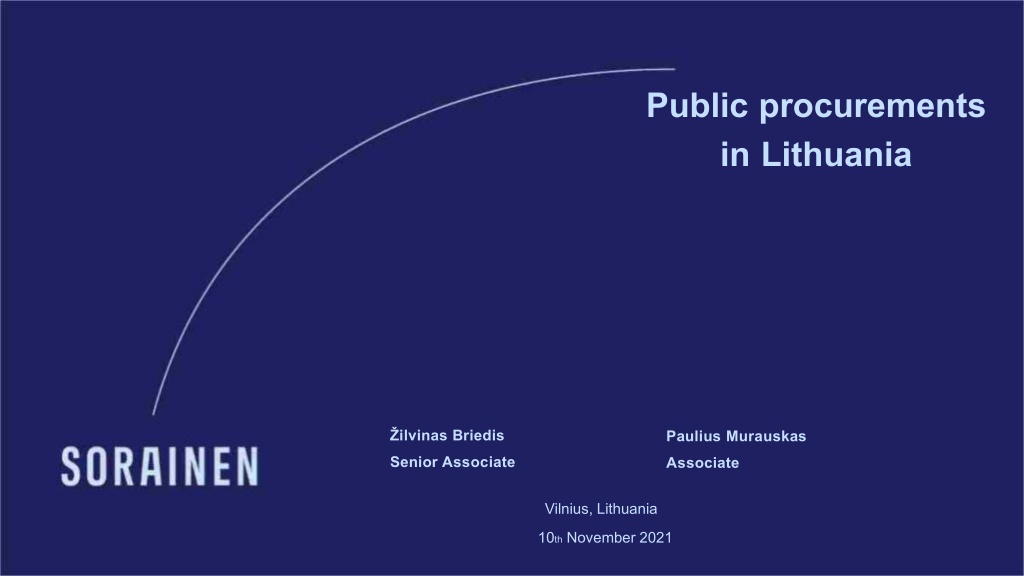


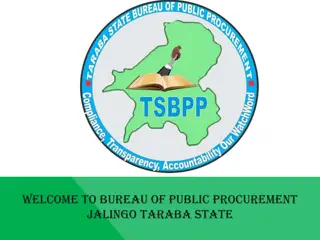
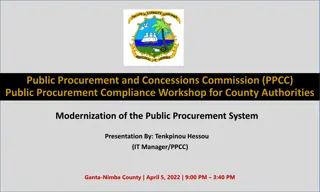
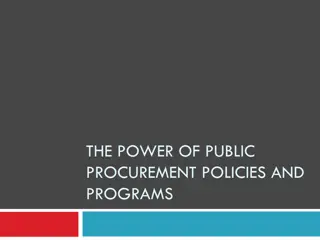
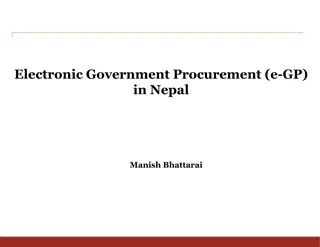

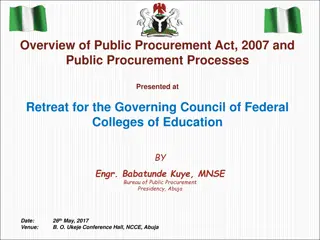
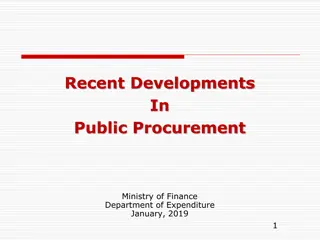
![Comprehensive Overview of Corruption Watch Submission on Public Procurement Bill [B18B-2023]](/thumb/138344/comprehensive-overview-of-corruption-watch-submission-on-public-procurement-bill-b18b-2023.jpg)
